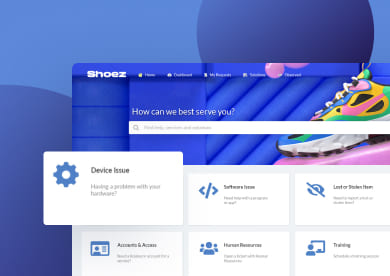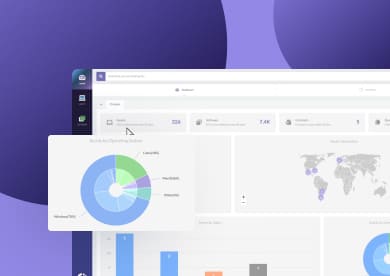If you're looking for Asset Panda® alternatives and competitors, we compiled the details from five other options in the IT Asset Management (ITAM) market to help you out with your review process.
Methodology
Before jumping into the analysis, it's important for you to know that InvGate develops and markets IT Service Management and IT Asset Management solutions, which means we are an active participant in this software category.
While we may compete with some of the vendors mentioned in this article, our goal is to provide accurate, transparent, and helpful information to help readers make informed decisions.
Our comparisons are based on publicly available information from vendor websites, product documentation, user reviews (such as those on Gartner Peer Insights, G2, and Capterra), analyst reports, and independent testing or demonstrations when possible. Each evaluation considers functionality and pricing (when publicly disclosed).
Information in this article is current as of October, 2025, and will be reviewed and updated periodically to reflect product or market changes.
Asset Panda overview
Asset Panda is a cloud-based asset tracking and management platform that enables organizations to manage the full lifecycle of physical and IT assets. In multiple independent reviews, it is praised for its customization, mobile functionality, and robust reporting features.
According to Software Advice, Asset Panda supports roles-based security, barcode scanning, automated reporting, and works across devices (Windows, macOS, iOS, Android).
Key features of Asset Panda
- Mobile and barcode scanning – The mobile app supports barcode scanning and updates from the field. (Source: Forbes)
- Reporting and analytics – Custom reports, scheduled email reports, asset depreciation, and audit trails are supported. (Source: Software Advice, linked above)
- Role-based security and permissions – Finances Online reports that users can be given restricted access based on roles.
- Integrations – Standard integrations (e.g. Zendesk, ConnectWise) are available; premium integrations (Jamf, Azure AD) are optional add-ons. (Source: Forbes, linked above)
- Lifecycle and maintenance tracking – Asset Panda supports maintenance, repair, and disposal tracking. (Source: Forbes, linked above)
Asset Panda rating reviews
Consulted in October, 2025, these are Asset Panda's rating reviews:
- Gartner Peer Insights: 4.3 out of 5 stars.
- G2: 3.9 out of 5 stars.
- Capterra: 4.6 out of 5 stars.
Asset Panda pricing
As of October, 2025, Asset Panda's pricing page informs the following:
- Starter: $50/user/month (billed annually).
- Business+: $60/user/month (billed annually).
- Enterprise: pricing not publicly disclosed.
- 14-day free trial available.
5 best Asset Panda alternatives for 2026
#1. InvGate Asset Management overview

InvGate Asset Management is a no-code cloud and on-premise ITAM solution that automatically discovers hardware, software, virtual, and cloud assets across the IT environment, consolidating them into one centralized platform.
InvGate Asset Management delivers Software License Management, compliance, IT spend optimization, and automated Lifecycle Management.
InvGate Asset Management features
- Automated IT asset discovery – Agent and agentless scanning to detect and inventory all connected devices, ensuring an accurate record.
- Asset Lifecycle Management – Asset monitoring from purchase through maintenance to retirement, with alerts for warranties and renewals.
- QR and barcode capabilities – Asset tagging and mobile scanning for quick identification and updates.
- Custom dashboards and reporting – Dashboard and report personalization to track preferred metrics, costs, and performance.
- Native IT integrations – Native integrations with ITSM platforms, including InvGate Service Management, remote access tools, Device Management solutions, and Identity and Access Management (IAM) systems.
InvGate Asset Management rating reviews
- Gartner Peer Insights: 4.8 out of 5 stars.
- G2: 4.7 out of 5 stars.
- Capterra: 4.4 out of 5 stars.
InvGate Asset Management pricing
- Starter: $0.21 node/month (billed annually).
- Pro: $0.38 node/month (billed annually).
- Enterprise: Custom pricing with on-premises option and advanced features.
- 30-day free trial available.
#2. Atera overview

Atera is an all-in-one, cloud-based IT Management platform that combines remote monitoring and management (RMM), helpdesk/ticketing, Patch Management, and automation into a single solution.
The vendor presents its offering as enabling “autonomous IT” via built-in AI agents to reduce repetitive tasks and boost efficiency.
Atera key features
- Remote monitoring and management – Real-time device monitoring and alerting across Windows, macOS and Linux environments. (Source: official site)
- Help desk and ticketing – Built-in ticketing system with automations, chat functions, and service-workflow integrations. (Source: official site, linked above)
- Patch Management – Automates operating-system and third-party patching for endpoints, helping maintain security and compliance. (Source: official site, linked above)
- Integration and automation – Supports script-based workflows, Azure AD sync, remote access (Splashtop, AnyDesk), and third-party integrations. (Source: Software Advice)
- Reporting and analytics – Offers dashboards, audit logs, unmanaged device visibility and custom asset-type tracking to support ITAM or ITSM oversight. (Source: official site, linked above)
Atera rating reviews
- Gartner Peer Insights: 0 out of 5 stars (under Endpoint Management tools; 4.7 under AI ITSM platforms).
- G2: 4.6 out of 5 stars.
- Capterra: 4.5 out of 5 stars.
Atera pricing
As of October, 2025, Atera's website specifies the following pricing structure for IT departments:
- Professional: $149/technician/month (billed annually).
- Expert: $189/technician/month (billed annually).
- Master: $219/technician/month (billed annually).
- Enterprise: not disclosed publicly.
- 30-day free trial available.
#3. SpiceWorks Inventory Online overview

Spiceworks Inventory Online is a cloud-based IT asset discovery and Inventory Management platform. It enables organizations to scan networks, collect device and software details, and maintain visibility into their environment.
SpiceWorks Inventory Online key features
- Network discovery and inventory scanning – Automatically scans devices on the network and collects hardware/software details. (Source: official website)
- Web-based access – Because it is cloud-hosted, the inventory can be accessed from anywhere without on-premises server installation. (Source: G2)
- Unified asset tracking – Captures both IT devices and software information, helping to support ITAM practices. (Source: Tech.co)
- Free-tier model with unlimited assets/users – Provides inventory functionality without asset or user limits under the free offering. (Source: Tech.co, linked above)
- Integration with help desk tools – Works alongside other tools in the vendor’s ecosystem (e.g., ticketing) for tighter alignment with IT Service Management workflows. (Source: Tech.co, linked above)
SpiceWorks Inventory Online rating reviews
- Gartner Peer Insights: No specific publicly cited overall rating found.
- G2: 4 out of 5 stars.
- Capterra: Not specifically listed for the “Online” variant in available sources.
SpiceWorks Inventory Online pricing
According to the vendor's website, it offers a free tier of the product.
#4. GroWrk

GroWrk is a cloud-based IT Asset Management platform aimed at supporting global and distributed workforces through device lifecycle automation. The vendor emphasises “procure, configure, deploy, store, reuse and recycle” devices across more than 150 countries with SOC 2 Type 2 certification and a “pay-only-for-what-you-use” pricing model.
GroWrk key features
The vendor's website specifies the following features:
- Device lifecycle automation – Automates procurement to recycling across a global footprint.
- Global procurement and deployment – Capability to deploy assets in 150+ countries through certified resellers.
- Security and compliance (SOC 2 Type 2) – Provides enterprise-grade controls and compliance standards.
- Integration ecosystem – 40+ integrations and a public API to connect the ITAM platform with existing workflows.
- Mobile and zero-touch deployment – Supports remote device deployment for MacOS, Windows, or Linux workstations.
GroWrk rating reviews
- Gartner Peer Insights: No publicly disclosed overall rating found.
- G2: 4.5 out of 5 stars.
- Capterra: 0 out of 5 stars.
GroWrk pricing
As of October 2025, the official website lists three subscription types (A La Carte, Flex, and All-in). The first one is "free to use", though users need to "pay as they go". Flex and All-in plans are subscription-based and their prices are not publicly disclosed.
#5: ManageEngine AssetExplorer

ManageEngine AssetExplorer is a web-based ITAM solution designed to give organizations visibility and control over hardware and software assets throughout their lifecycle.
According to a Forbes review, it supports asset discovery, tracking, software-license compliance, purchase-order and Contract Management, and Hardware/Software Lifecycle Management.
ManageEngine AssetExplorer key features
- Asset discovery and Inventory Management – Automatically scans networks to identify hardware and software assets, providing a unified inventory view. (Source: Technology Evaluation Centers)
- Software license and Compliance Management – Tracks software license usage, renewal dates, and compliance with license terms. (Source: Finances Online)
- Purchase order and Contract Management – Manages asset procurement, vendor contracts, expiry dates, and lifecycle workflows. (Source: Technology Evaluation Centers, linked above)
- Lifecycle tracking & cost monitoring – Tracks assets from procurement through disposal, and provides cost-visibility and utilization insights. (Sources: Forbes and Technology Evaluation Centers, linked above)
- Reporting and analytics – Offers built-in reports and dashboards to support audits, compliance reviews, and asset-utilization decisions. (Sources: Software Advice and Forbes, linked above)
ManageEngine AssetExplorer rating reviews
- Gartner Peer Insights: 4 out of 5 stars.
- G2: 4.3 out of 5 stars.
- Capterra: 4.6 out of 5 stars.
ManageEngine AssetExplorer pricing
As of October 2025 and according to its website, ManageEngine AssetExplorer is charged based on number of assets, for example:
- 250 IT assets: $1245 (billed annually).
- 500 IT assets: $2345 (billed annually).
- 1000 IT assets: $3895 (billed annually).
The company also offers monthly license fees and a 30-day free trial that offers up to 250 IT assets.
Disclaimer: All product names, logos, and brands are property of their respective owners. All company, product, and service names used on this site are for identification purposes only. Use of these names, trademarks, and brands does not imply endorsement. Comparisons are based on publicly available information as of October, 2025 and are provided for informational purposes only.















